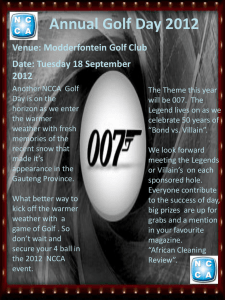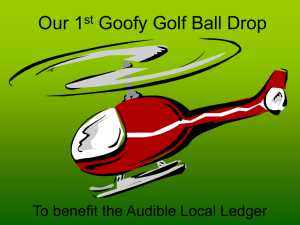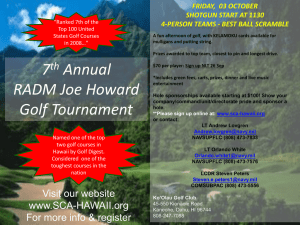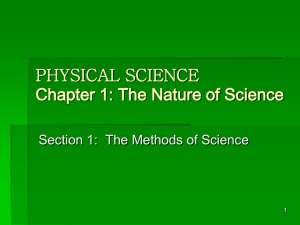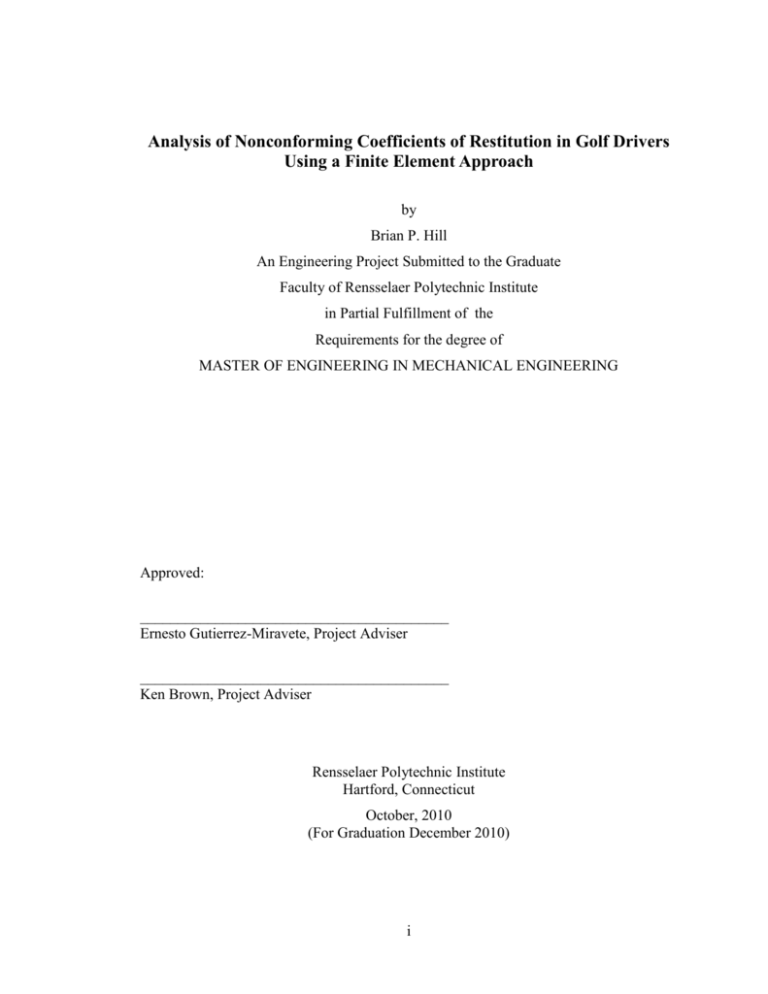
Analysis of Nonconforming Coefficients of Restitution in Golf Drivers
Using a Finite Element Approach
by
Brian P. Hill
An Engineering Project Submitted to the Graduate
Faculty of Rensselaer Polytechnic Institute
in Partial Fulfillment of the
Requirements for the degree of
MASTER OF ENGINEERING IN MECHANICAL ENGINEERING
Approved:
_________________________________________
Ernesto Gutierrez-Miravete, Project Adviser
_________________________________________
Ken Brown, Project Adviser
Rensselaer Polytechnic Institute
Hartford, Connecticut
October, 2010
(For Graduation December 2010)
i
© Copyright 2010
by
Brian P. Hill
All Rights Reserved
ii
CONTENTS
Analysis of Nonconforming Coefficients of Restitution in Golf Drivers Using a Finite
Element Approach ........................................................................................................ i
LIST OF TABLES ............................................................................................................ iv
LIST OF FIGURES ........................................................................................................... v
NOMENCLATURE ......................................................................................................... vi
ACKNOWLEDGMENT ................................................................................................. vii
ABSTRACT ................................................................................................................... viii
1. Introduction.................................................................................................................. 1
1.1
Background ........................................................................................................ 1
1.2
Coefficient of Restitution ................................................................................... 1
1.2.1
History of COR in Golf .......................................................................... 2
1.2.2
Testing COR for Drivers ........................................................................ 2
1.3
Problem Description........................................................................................... 3
1.4
Previous Work.................................................................................................... 4
2. Methodology ................................................................................................................ 6
2.1
Finite Element Model Development .................................................................. 6
2.2
LS-DYNA Contact Analysis .............................................................................. 7
3. References.................................................................................................................... 8
iii
LIST OF TABLES
Table 1: Material Properties for Titanium Test Plate ....................................................... 3
Table 2: Material Properties & Dimensions for 3 Piece Golf Ball ................................... 4
Table 3: Velocity and Thickness Analysis Runs .............................................................. 7
iv
LIST OF FIGURES
Figure 1: Specifications for Titanium Test Plate .............................................................. 3
Figure 2: Cross Section of Areas Used for Axisymmetric Modeling ............................... 6
Figure 3: Cross Section of Model Expanded 270 Degrees ............................................... 7
v
NOMENCLATURE
e
Coefficient of Restitution (-)
Vin
Initial Velocity (m/s)
Vout
Exit Velocity (m/s)
Density (kg/m3)
E
Modulus of Elasticity (MPa)
E0
Initial Modulus of Elasticity (MPa)
Poisson’s Ratio (-)
yield
Yield Stress (MPa)
C01
Mooney-Rivlin Coefficient (MPa)
C10
Mooney-Rivlin Coefficient (MPa)
D
Diameter (mm)
Vy
Y-Component of Velocity (m/s)
t cf
Clubface Thickness (mm)
vi
ACKNOWLEDGMENT
I would like to thank the academy.
vii
ABSTRACT
viii
1. Introduction
1.1 Background
Golf clubs have seen a dramatic improvement over recent years with the advancement in
materials and manufacturing technologies. The number 1 wood, commonly known as
the driver, is no longer made with a combination of hardwoods or steels. Instead they
utilize the weight and strength benefits of graphite composites for shafts and titanium
alloys for the clubhead. Even today, as the equipment advances, rules are often imposed
or updated to keep the game fair and balanced. In 1984, around the time titanium drivers
were in the experimental stages, the United States Golf Association (USGA)
implemented Appendix II, (5a.) to the USGA Rules of Golf, which states;
“The material and construction of, or any treatment to, the face or
clubhead shall not have the effect at impact of a spring, or impart
significantly more spin to the ball than a standard steel face, or have any
other effect which would unduly influence the movement of the ball.”
There was one underlying reason for this rule addition. The thin clubfaces achievable
with hollow titanium drivers demonstrated a unique phenomenon during impact with a
golf ball. It was observed that the clubface would deform upon impact, and return to its
original geometry after, much like a trampoline. Thus the term “trampoline effect” was
coined. In the older solid wood and steel clubs, the face was almost completely rigid
and most of the energy loss during impact (friction, heat, sound, etc.) was occurring in
the golf ball. With the trampoline effect, the clubface absorbs some of the energy
normally lost at impact and imparts it back into the ball, like a spring.
1.2 Coefficient of Restitution
Coefficient of restitution, or COR, measures the efficiency of the energy transfer during
an impact event. COR is represented as a ratio, with a value from 0 to 1. A COR with a
value of 0 represents a perfectly inelastic collision. An example of this would be two
bodies coming to a complete stop during an impact. A COR with a value of 1 portrays a
perfectly elastic collision, in which no energy is lost during impact. Usually COR is
measured in terms of pre and post impact velocities. For example, take a ball hitting a
rigid plate with an initial velocity of 100 mph, and a post impact velocity of 80 mph.
1
This impact has a COR of 0.80 or 80% of the ball’s energy was returned to the ball after
impact. Equation 1 below shows the formulation.
COR e
1.2.1
Vout
Vin
(1)
History of COR in Golf
The USGA limited the COR in drivers to 0.830 in 1998, while the other governing body
for golf outside the US, the Royal & Ancient Golf Club of St. Andrews (R&A), did not
impose a limit on COR at that time. This caused confusion as to what drivers were
allowed during play, especially for international events. In May of 2002, talks between
the two governing bodies unveiled a proposal to establish the limit from 0.830 to 0.860
to create some uniformity around the globe. Some manufacturers began producing
drivers that exceeded the 0.830 limit in July of 2002, even though the rule was not yet
official.
This caused signification turbulence when the USGA decided to maintain its
limit of 0.830, and the R&A decided it would enact the same limit beginning in 2008.
These new drivers with nonconforming COR, or “hot” drivers, were deemed illegal for
all tournament play and handicapped based rounds.
1.2.2
Testing COR for Drivers
With the introduction of these limits, The USGA needed a test procedure to measure a
driver’s COR. Originally, a ball was fired by air cannon into a specimen and pre and
post impact velocities were compared to find COR. This was a timely process when
considering the set up and the controls associated with the golf balls used in the test.
Today, the COR is measured using the “Characteristic Time” test, which consists of a
steel ball with sensors on a pendulum being swung into a clubface. The length of time
the steel ball is in contact with the face determines the COR. For the purpose of this
analysis, the model will refer back to the original testing procedure.
2
1.3 Problem Description
The goal of this project is analyze the trampoline effect and nonconforming CORs in
drivers using finite element software. The changes in COR will be noted while varying
the clubface thickness and initial velocities. For reference, at a swing speed of 100 mph
a club at the COR limit of 0.830 will hit the ball around 10-15 yards more than a club
with a rigid clubface (COR of about 0.770). At 100 mph, the average difference in
performance between 0.860 and 0.830 COR is about 5.6 yards more. At slower swing
speeds the difference is even less. Thus, the trampoline effect essentially only benefits
better players with higher swing speeds
The basis of the model will use the geometry and properties of a representative clubface
originally used to calibrate the test rig in the outdated air cannon USGA COR test. The
representative plate is made out of a titanium alloy to a specified weight of 190g. Its
material properties are shown below in Table 1 and the geometry is shown in Figure 1.
Table 1: Material Properties for Titanium Test Plate
Material
E
yield
Ti-Al6V4
4,500
113,000
0.34
1,100
Figure 1: Specifications for Titanium Test Plate
3
The golf ball will be based off of previous articles, and consist of three layers. The Ball
will have a hard ionomer resin cover and a soft, rubber like polybutadiene core and
mantle. The properties are specified in Table 2 below.
Table 2: Material Properties & Dimensions for 3 Piece Golf Ball
Material
E0
C01
C10
D
Butadiene (core)
1,150
50
0.49
10.2
1.46
35.2
Butadiene (mantel)
1,150
25
0.49
5.83
0.83
1.8
Ionomer (cover)
950
400
0.49
43.8
6.25
2
For the preprocessing and creation of the clubface model, ANSYS ED will be used. The
associated simulation of the impact will be done using LS-DYNA. LS-DYNA uses an
explicit solver to simulate such impacts. An explicit solver predicts the state variables of
a dynamic system at time t + dt using the state variable of the system at time t
1.4 Previous Work
While no articles could be found that specifically investigated the trampoline effect,
several articles have been written on the subject of finite element analysis on golf
equipment. The majority of articles found related to the topic of properly modeling the
dynamics of golf balls at impact. The unique inelastic and hyper-elastic properties of the
golf ball required precise element, material, and mesh choices.
Many studied the
validity of the FE model by comparing it to results of a simplified physical test. One
article that is consistently referenced by later works suggested the idea of MooneyRivlin rubber elastic modeling for finite element analysis. This article went into great
detail on proper material modeling and the effects on the finite element results. It further
compared these results to physical data and also validated the method by applying it to
another golf ball.
Another previously published work aimed to optimize clubface design using the
mechanical impedance matching theory. This theory suggests that the most efficient
impact occurs when the natural frequencies of the colliding bodies is equal. The idea
4
was to use modal analysis to find the natural frequencies of the clubface and ball. The
ball showed significantly lower frequencies than the clubface. Design modifications
were implemented into the clubface in an attempt to lower the club’s frequency to better
match the balls’. The resulting clubface design resulted in better performance on the
rebound velocity of the golf ball.
5
2. Methodology
2.1 Finite Element Model Development
In order to limit the size of the model in ANSYS ED and reduce the simulation run time,
a 2-d axisymmetric model will be made vice a 3-d model. A cross section of the
titanium plate and 3 piece golf ball will be produced with symmetry about the y-axis.
The titanium plate was modeled as rectangular areas merged together using the merge
tool within ANSYS ED. The small chamfers and fillets shown in Figure 1 are ignored to
simplify the model and make meshing easier. The elements chosen are LS-DYNA
explicit Solid 162 elements. The elements can either be quadrilateral or triangular in
shape. However, quad elements produce much more accurate results and are therefore
preferred. The 3 piece ball was modeled as concentric axisymmetric semicircles about
the y-axis. The ball will use Mooney-Rivlin rubber elastic modeling characteristics
based on previous work. It will also be modeled using the Solid 162 elements. The
separate areas for the different layers are joined together using the merge tool. This is to
ensure that all the components of the ball move as one during the impact event. The
different colors represent the different areas within the model. This cross section is
shown in Figure 2 below.
Figure 2: Cross Section of Areas Used for Axisymmetric Modeling
6
Using the axisymmetric expansion option within ANSYS, the cross section can be
revolved around the y-axis a specified number of degrees. Below in Figure 3, the cross
section is expanded 270 degrees.
Figure 3: Cross Section of Model Expanded 270 Degrees
2.2 LS-DYNA Contact Analysis
The ball is initialized to have a negative y velocity component . This is to replicate the
air cannon speed used in the outdated USGA COR test. The same speed will be used for
three varying clubface thicknesses and then altered. The speeds used for the initial y
velocity will be representative to that of a range of male swing speeds. This analysis
will investigate the clubface thicknesses shown in Table 3 below at speeds of 49.2 m/s,
44.7 m/s, 40.2 m/s.
Table 3: Velocity and Thickness Analysis Runs
Vy
t cf
Vy
t cf
Vy
t cf
49.2
3.175
44.7
3.175
40.2
3.175
49.2
2.540
44.7
2.540
40.2
2.540
49.2
1.905
44.7
1.905
40.2
1.905
7
3. References
K. Tanaka et al., Construction of the finite-element models of golf balls and simulations
of their collisions, Proc. of the Institution of Mechanical Engineers, Part L: J of
Materials: Design and Applications 220 (1) (2006), pp. 13–22.
Petersen, Willem et al., Shape optimization of golf clubface using finite element impact
models, International Sports Engineering Organization, December 2009
A.W. Pugh et al., Characterization of the materials in golf ball construction for use in
finite element analysis, Procedia Engineering, Volume 2, Issue 2, The
Engineering of Sport 8 - Engineering Emotion, June 2010, Pages 3231-3236
K. Tanaka et al., Experimental and finite element analyses of a golf ball colliding with a
simplified club during a two-dimensional swing, Procedia Engineering, Volume
2, Issue 2, The Engineering of Sport 8 - Engineering Emotion, June 2010, Pages
3249-3254
GOLF CHANNEL Newsroom. “USGA, R&A Rule on 'Spring-Like' Effect.”
thegolfchannel. August 6, 2002. September 21, 2010
<http://www.thegolfchannel.com/tour-insider/usga-ra-rule-spring-like-effect6874/>
“What is C.O.R.? What is CT?” wishongolf. September 21, 2010
<http://www.wishongolf.com/faq_tech_answer.php?techKey=1>
“Conflicts surrounding the Callaway ERC driver.” golftoday. September 21, 2010
<http://www.golftoday.co.uk/news/yeartodate/news01/callaway.html>
8
“Coefficient of restitution.” wikipedia. September 21, 2010
<http://en.wikipedia.org/wiki/Coefficient_of_restitution>
Kelley, Brent. “Clubhead Speed.” about. September 26, 2010
<http://golf.about.com/od/golfterms/g/clubheadspeed.htm>
www.fanklygolf.com, September 21, 2010.
<http://www.franklygolf.com/driver-cor-springlike-effect.aspx>
9


